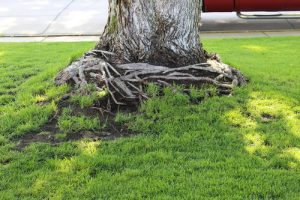Written by Healthy Trees and published on https://www.healthytrees.com/.
A tree is girdled when something is tightly wrapped around the trunk or stem. A stem girdling root circles or partially circles the base of a tree at or just below the soil surface. Stem girdling roots choke off the flow of water and nutrients between the roots and branches and food produced in the leaves from reaching the roots. They can also compress and weaken the trunk of a tree at or above the root collar flare (the junction between the trunk and the main roots) causing it to lean and lose its stability. Girdling roots may girdle other roots, but there is no known harm in this. Trees having stem girdling roots suffer a slow decline in health and a premature death.
What are Girdling Roots and How do They Effect Trees?

Girdling roots to a tree, is a similar experience to overeating while wearing a belt. When our favorite dish is placed directly in front of us, we cannot help but indulge. Upon indulging, we notice the space between our stomach and belt gradually decreases, resulting in a squeezing sensation. Lucky for us, we can release that tension by removing our belt. Girdling roots require certified arborists assistance to remove this squeezing nuisance that, in turn, could be detrimental to the tree’s health.
Girdling roots are lateral roots that lie directly, or sometimes breach, the soil surface. These roots cut into one side of the trunk, restricting water and nutrient movement throughout the entire tree. While girdling roots generally take five to fifteen years to slowly weaken the tree, resulting in death, environmental factors, or disease paired with girdling roots can result in a much shorter lifespan.
What Causes Girdling Roots
The main causes of girdling roots come from an excessive placement of soil over the roots causing obstruction, nursery transplanting practices, and some factors not yet identified.
Compacted soil surrounding the roots initial planning hole results in difficulty growing outward. The soil forces the roots to circle at the bottom of the planning hole, risking the chance of girdling roots to occur.
Similarly, when a tree is not permitted to grow beyond its nursery container, its roots find other means to grow – circling at the bottom. During the planting process of the new tree, roots must be loosened to initiate outward growth, to combat against girdling.
Detecting Girdling Roots
Detecting girdling roots generally does not require an expert, unless you are a novice.
Similar to overeating and having our stomachs bulge, tree trunks flare upon feeling girdling roots. This abnormal flare occurs around where the trunk meets the ground and can result in the trunk appearing straight or even narrower.
As stated before, girdling roots may breach the soil line in an attempt to circle the trunk above but is not likely. You’re most likely to notice unseasonably small leaves, premature leaf falling, or a smaller canopy.
Treating and Preventing Girdling Roots
To prevent girdling roots, preemptive measures must be considered. When planting a tree, ensure the size of your planting hole accommodates the entirety of the tree and roots going into it. This means digging a hole two to three times the width of the root ball and a height no deeper than the root ball, so soil buildup above the root flare does not occur.
If circling roots within the nursery container occur, break them up prior to planting to ensure outward root growth. When continually watering the new tree, check up on the root flare for any abnormalities.
Finally, if you’ve determined girdling roots must be removed, as always, we recommend consulting a certified arborist. Certified arborists understand the weakening capabilities of girdling roots and the correct removal process to ensure the longevity of your tree.
Consider contacting one of our certified arborists at Wachtel to pinpoint your girdling roots or remove them to ensure the success of your tree.
Original post here https://ift.tt/2CqEmlk.
from AAA Tree Lopping Ipswich https://ift.tt/2RLTPo3
via IFTTT
No comments:
Post a Comment